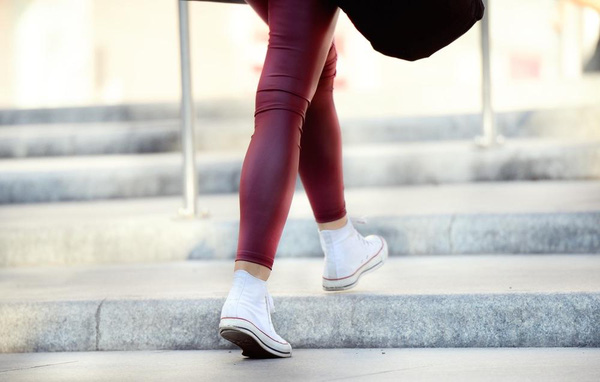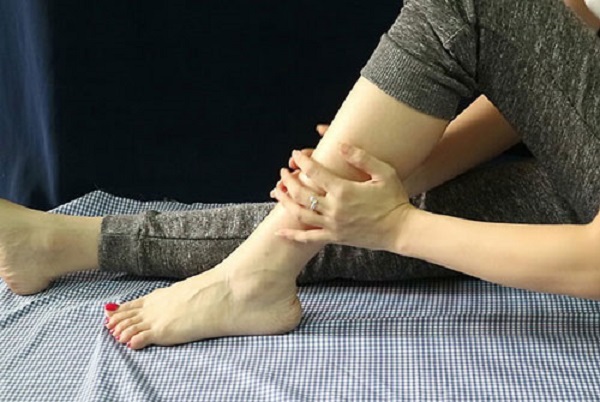Many patients with varicose veins have a misconception about the disease, such as: varicose veins are not allowed to walk, not to climb stairs, or just take medicine should not be operated ...
Good walking for varicose veins
Walking is beneficial for people with varicose veins, the blood is pushed to the heart to reduce congestion and reduce pressure in the superficial veins. Effective treatment requires a combination of measures, with lifestyle changes playing a fundamental role.
Walking is a light exercise with many benefits, so most people choose to practice. Most patients after varicose veins have abandoned walking habits, even some people do not dare to exercise for fear of making the disease worse. Even specialists have different opinions on this issue.

Walking, climbing stairs is good for people with varicose veins.
When standing upright, the blood in a vein has to overcome gravity to flow back to the heart. To do this, the muscles have to squeeze the deep veins in the legs and feet in sync with the opening and closing of the venous valves. When the muscles in the legs contract, the valves in the veins open. When the muscle relaxes, the valve closes, preventing the upper blood from flowing backwards. The whole process of returning blood to the heart is called intravenous pumping. With this method of operation, the valves create a system of direct current from bottom to top and from shallow to deep.
Varicose veins occur when the valves in the veins of the veins fail and cannot close. At that time, blood flows backwards under the opening of the venous valve, causing stagnation and increased venous pressure. Deep veins can tolerate increased pressure, while superficial veins that are surrounded by loose connective tissue will expand and become inflamed.
The phenomenon of stagnant blood increases venous pressure, causing pain, discomfort, superficial varicose veins, foot edema, changes in skin condition and sores. Therefore, the treatments for varicose veins are aimed at overcoming the situation of increased venous pressure due to stasis.
How walking affects the veins
When the heel is lifted high, blood from the venous plexus below the heel and the sole of the foot (Bejar plexus) will be pushed into the deep veins of the lower leg. Then, the calf contraction pushes blood back to the vein of the thigh area. Just like that, the blood flow to the vein is higher, then the heart.
Muscle contraction while walking will help the venous pump work effectively. The force of muscular force in the deep vein system measured during active exercise is much higher than when standing still. Thereby helping the blood is pushed to the heart, reducing congestion as well as pressure in the superficial veins.
Thus walking helps push blood from the deep vein system to the heart better, reducing the pressure of the superficial veins. Thereby reducing the symptoms and clinical manifestations of venous insufficiency.
Most people with varicose veins report feeling better after a period of walking and lifestyle changes. In the case of Ms. Van, who suffered from a venous vein, which caused pain and discomfort in her legs, she treated it 2 years ago but did not get better. She recently combined treatment and lifestyle changes, learning to walk on the advice of a doctor, after only a short time, the pain subsided. Patients continue to walk and climb stairs every day when symptoms improve markedly.

Walking reduces the risk of leg ulcers in varicose veins
The study found that people with chronic venous insufficiency who walked less than 10 minutes a day were at a higher risk of developing foot ulcers than those who remained active for more than 10 minutes. Vascular surgery associations around the world recommend that patients with venous insufficiency should walk.
Note: if the patient does not have the habit of walking, it should start slowly, then gradually increase the amount of time and distance. In the early stages, you may experience discomfort or leg pain, but will improve later. Walking requires a flexible movement of the ankle to be effective. People with leg ulcers due to varicose veins will have limited ankle movement, so they need to be treated with ankle therapy and pain therapy before walking.
Source Vnexpress
City International HospitalShould you have any questions, please do not hesitate to contact us:
- Address: No. 3, 17A Street, Binh Tri Dong B Ward, Binh Tan Dist. (Next to AEON Mall Binh Tan). Ho Chi Minh City.
- Operator: (+8428) 6280 3333, ext. 0
- 24/7 Emergency: (+8428) 6290 1155
- Website: https://cih.com.vn/en/
- Fan page: https://www.facebook.com/BenhVienQuocTeCity/
- Email: This email address is being protected from spambots. You need JavaScript enabled to view it.
General disclaimer
Always consult your doctor regarding any concern about your health. Your doctor will be in the best position to give the appropriate medical advice. For suspected undesirable drug reaction and seek medical attention immediately.










